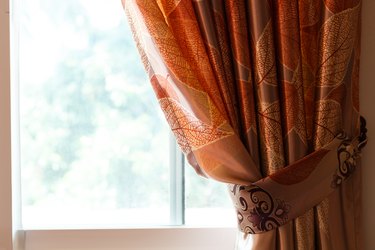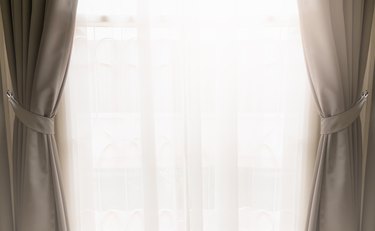
Generally, curtain tiebacks look best when placed one-third of the way from the top or bottom of the curtain. Tiebacks are both functional and decorative elements of a window treatment. These fabric bands or metal hooks hold the drapes or curtains back from the window. Releasing one end of the tieback allows the curtain to close. The height at which they are attached to the wall depends on the style of the window treatment, the size and shape of the window, and the functionality required. A few guidelines will help you determine the correct placement for tiebacks.
Hang Them High
Video of the Day

Placing tiebacks high makes the window look taller, because it exposes more glass. This is a fairly modern tieback placement and is best suited to casual decor styles such as a country motif. High tiebacks also work well in a little girl's room. If the tiebacks are to be functional as well as decorative, keep them low enough that you can reach them easily when closing the curtains. To place tiebacks high, measure the length of the curtains and divide by three. Place the tiebacks a third of the way down the curtain or as close to it as possible to keep the tiebacks within reach.
Video of the Day
Hang Them Low

Low tiebacks allow the top portion of the curtain to hang down in a wide, sweeping manner. More decorative than functional, low tiebacks give curtains an elegant and formal look, making them perfect for use in formal dining and living rooms. Though beautiful, be aware that this configuration blocks quite a bit of natural light. To achieve proper placement, again measure the length of the curtains and divide by three. Hang each tieback a third of the way up from the bottom of the curtain. If, for example, the drape is 100 inches long, you would place the tieback 33 inches from the bottom.
Don't Do It Half
It's oft-repeated advice that you should never do anything halfway. This mantra works well for both life and curtain tiebacks. When you place curtain tiebacks smack in the middle of the fabric, you cut the window in half and make it look shorter. The result is a perfectly symmetrical look that appears forced and rigid rather than natural and warm. Tiebacks placed in the middle of curtains are a decorating taboo.
Forget Everything You Now Know
The standard rules for curtain tieback height will serve you well most of the time. Much like the pirate code, however, these rules are more like guidelines. What matters most is how your curtains look. Before mounting a tieback to your wall, have a friend hold it in the desired position while you step back and take a look. If it looks bad, move it. It's acceptable to break the rules of tieback placement if the curtains look good in the end.
